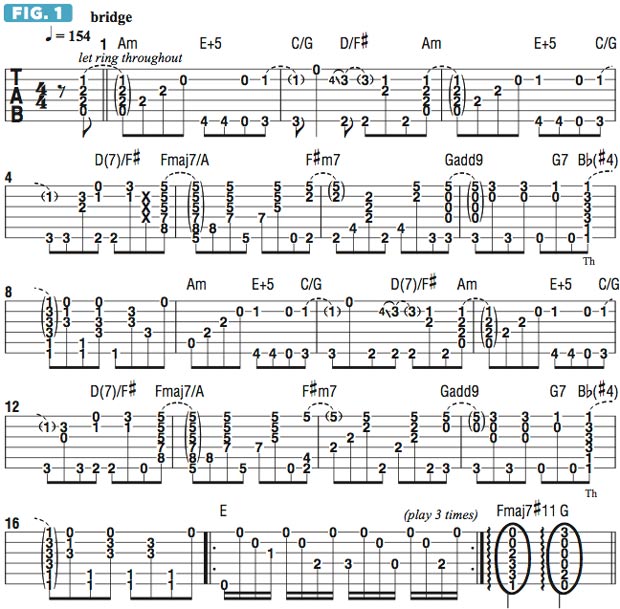Thematic Development, and the Bridge of “T.E. Ranch”
Learn more about thematic development from acoustic maestro Tommy Emmanuel.

Last month, I demonstrated how to play the main theme to my tune “T.E. Ranch,” from my latest release, It’s Never Too Late. This month, I’d like to show you the tune’s bridge section.
As I’ve detailed in previous columns, I often rely on what’s commonly known as the “Merle Travis” picking style (“Travis picking,” for short) in the performance of many of my tunes, wherein the bottom three strings are always picked in an “alternating bass” fashion with the thumb, and melodic lines that fall on the higher strings are picked with the index and middle fingers and occasionally the pinkie.
Essential to each performance is absolute precision in defining the song’s melodic line rhythmically: some notes fall squarely on the downbeats, in sync with the bass notes, and some fall in the spaces between the bass notes, on the upbeats. I like to play as freely as possible, and oftentimes a bar is a little bit different than its predecessor, so focus on each bar individually.
The bridge section features a modulation from A major to A minor, and additionally I switch from the verse’s alternating bass approach to a “pumping” bass-notes attack in order to create more tension and drama in the musical story. In bars 1–4 of FIGURE 1, I spend a significant amount of time picking straight eighth notes on the low E string, specifically in the second half of bars 1, 2 and 3 and on each beat in bar 4. Starting in bar 5 and through bar 6, I switch to a “triplet”-type picking pattern, in that I pick the bottom three strings in succession in straight eighth notes, additionally plucking the top three strings along with the D string.
Utilizing a picking pattern based on this kind of repeating three-note contour played in a straight-eighths rhythm is known as a “threes on fours” pattern. It can be tricky to move smoothly from the Fmaj7/A to F#m7 to G(add4) to Bb(#4) and keep the picking articulation crystal clear, so work through these bars slowly at first and gradually build up speed.
In bars 7 and 8, I change the picking pattern again, now picking the sixth string on each downbeat, alternating with the higher strings on the eighth-note upbeats. Bars 9–16 are basically a recap of bars 1–8 with slight improvised variations. In bar 17, I introduce a fast picking pattern played in straight 16th notes: after first striking the sixth string with my thumb, I pick the first and second strings with my middle and index fingers, respectively, and then pick the third string with my thumb. The top two strings are picked again in a similar manner, and then I introduce a melody on the fourth string that moves from E, the root note, to F, the b9 (flatted ninth), to D, the b7 (flatted seventh) and then back to E. This pattern must be executed very quickly, so to me this is the most challenging part of the tune to master.
The 16th-note pattern is played three times and is followed by half-note chord hits on Fmaj7#11 and G, after which we return to the tunes’ “head,” or verse section. Hope you have fun with this one!
All the latest guitar news, interviews, lessons, reviews, deals and more, direct to your inbox!

Tommy Emmanuel is an Australian guitarist, who's worked as a session player and won awards for his solo recordings. He is one of the finest acoustic players working today. In 2019, MusicRadar named him as one of the 10 best acoustic guitarists in the world.
